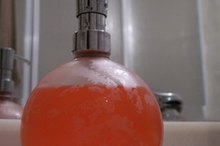What Is the Difference Between a Vial & an Ampule?
Ampules and vials rest on the shelves of pharmacies or chemical laboratories. Both types of containers play an active role in storing chemical fluids or solids that will be mixed with others or delivered to a patient. Although both refer to glass or sometimes plastic vessels, they benefit from different designs and serve different purposes.
Ampule
An ampule typically indicates a sealed glass container that holds some pharmaceutical compound 1. This device is sealed to protect its content from air or humidity. The closure of the small container results from melting the tip of the ampule. Its opening requires breaking the neck of the bottle.
- An ampule typically indicates a sealed glass container that holds some pharmaceutical compound 1.
- The closure of the small container results from melting the tip of the ampule.
Vial
How to Tell if a Thermometer Is Mercury
Learn More
A vial represents a broader term than an ampule. It includes any small container that holds pharmaceutical or chemical compounds. Typically made of glass, the vial can be sealed or not sealed. The vessel closes with a screw on cap, or a rubber plug. Sometimes, its top includes a dropper to measure the liquid to retrieve. The vial tends to have a flat bottom so that it can rest on a counter.
- A vial represents a broader term than an ampule.
- Sometimes, its top includes a dropper to measure the liquid to retrieve.
Potency Protection
Chemical elements that tend to be unstable in the presence of air or another compound remain intact and keep their potency when stored in an ampule. Frequently, drug manufacturers will pull the air out of an ampule before sealing it to prevent the medication from degrading within the container. A vial is typically not hermetic and best contains stable compounds.
Reuse
What Are the Dangers of Plastic Food Storage Containers?
Learn More
Since the ampule opens with a break of its shell, this container is not reusable. At times, snapping off of the ampule may be challenging and at times present risk of injury according to Ron Stoker, Executive Director of the International Sharps Injury Prevention Society. In contrast, a vial can be cleaned and reused several times and presents less risk of injury.
Volume Measurement
The container of an ampule experiences slight variations in its internal volume. This results from the sealing process that melts the glass. Typically, a syringe with volume indicators pulls some fluid from the ampule to size the required amount of medication. In contrast, a vial can provide accurate volume markings that become visual indicator of the remaining volume of product.
- The container of an ampule experiences slight variations in its internal volume.
- In contrast, a vial can provide accurate volume markings that become visual indicator of the remaining volume of product.
Mixing
Vials act as convenient containers to mix several chemical compounds together. Through their glass walls, the resulting compounds feature their consistency and colors. The broken glass edge of opened ampules presents the risk of introducing small glass debris into a mixture of chemical elements and therefore do not lend themselves to mixing products.
- Vials act as convenient containers to mix several chemical compounds together.
- The broken glass edge of opened ampules presents the risk of introducing small glass debris into a mixture of chemical elements and therefore do not lend themselves to mixing products.
Related Articles
References
Writer Bio
Nathalie Gosset started writing for technical journals such as “Lightwave” in 1990. Awarded the 2009 IEEE Engineer of the Year and 2007 EMBS Career Achievement recognitions for her philanthropic outreach, she authored her first professional development book, “Hidden Jobs, How to Find Them!” in 2009. Gosset has a Bachelor of Science in electrical engineering, a Master in Telecom and a Master of Business Administration.








